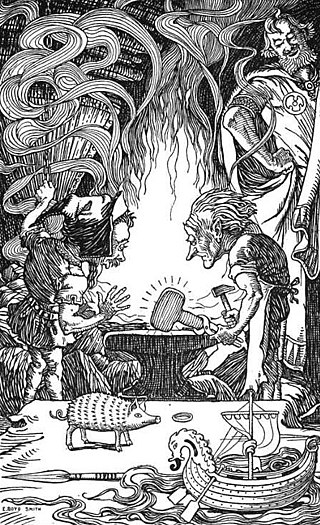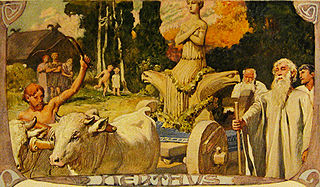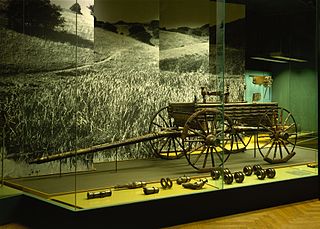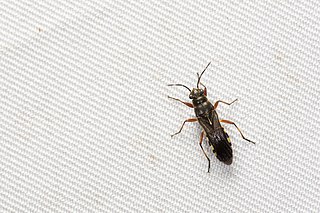
In Norse mythology, Njörðr is a god among the Vanir. Njörðr, father of the deities Freyr and Freyja by his unnamed sister, was in an ill-fated marriage with the goddess Skaði, lives in Nóatún and is associated with the sea, seafaring, wind, fishing, wealth, and crop fertility.

Sex is the trait that determines whether a sexually reproducing organism produces male or female gametes. A male organism produces small mobile gametes, while a female organism produces larger, non-mobile gametes. An organism that produces both types of gamete is called a hermaphrodite. During sexual reproduction, a male and a female gamete fuse to form a zygote, which develops into an offspring that inherits traits from each parent.

Gullinbursti is a boar in Norse mythology.

In Germanic paganism, Nerthus is a goddess associated with a ceremonial wagon procession. Nerthus is attested by first century AD Roman historian Tacitus in his ethnographic work Germania.

Germanic paganism or Germanic religion refers to the traditional, culturally significant religion of the Germanic peoples. With a chronological range of at least one thousand years in an area covering Scandinavia, the British Isles, modern Germany, and at times other parts of Europe, the beliefs and practices of Germanic paganism varied. Scholars typically assume some degree of continuity between Roman-era beliefs and those found in Norse paganism, as well as between Germanic religion and reconstructed Indo-European religion and post-conversion folklore, though the precise degree and details of this continuity are subjects of debate. Germanic religion was influenced by neighboring cultures, including that of the Celts, the Romans, and, later, by the Christian religion. Very few sources exist that were written by pagan adherents themselves; instead, most were written by outsiders and can thus present problems for reconstructing authentic Germanic beliefs and practices.
Fornjót is a jötunn in Norse mythology, and the father of Hlér ('sea'), Logi ('fire') and Kári ('wind'). It is also the name of a legendary king of "Finnland and Kvenland". The principal study of this figure is by Margaret Clunies Ross.
The Reudigni were one of the Nerthus-worshipping Germanic tribes mentioned by Tacitus in Germania. Schütte suggests that the name should be read Rendingi or Randingi and then the name would be the same as the Rondings of Widsith. They have otherwise been lost to history, but they may have lived in Denmark prior to the arrival of the Daner recorded by Jordanes. Schütte suggests that their name lives on in the names Randers and Rands Fjord, Denmark.
(Original Latin) "Reudigni deinde et Aviones et Anglii et Varini et Eudoses et Suardones et Nuithones fluminibus aut silvis muniuntur. Nec quicquam notabile in singulis, nisi quod in commune Nerthum, id est Terram matrem, colunt eamque intervenire rebus hominum, invehi populis arbitrantur. ..." --Tacitus, Germania, 40.
(English translation) "There follow in order the Reudignians, and Aviones, and Angles, and Varinians, and Eudoses, and Suardones and Nuithones; all defended by rivers or forests. Nor in one of these nations does aught remarkable occur, only that they universally join in the worship of Herthum (Nerthus); that is to say, the Mother Earth."--Tacitus, Germania, 40, translated 1877 by Church and Brodribb.
The Aviones or Auiones were one of the Nerthus-worshipping Germanic tribes of the 1st century mentioned by Tacitus in Germania, and they lived either in the southern Jutland Peninsula, or on Öland. They are mentioned in Widsith as Eowan.
The Suarines or Suardones were one of the Nerthus-worshipping Germanic tribes mentioned by Tacitus in Germania. They have otherwise been lost to history, but Schütte suggests that their name lives on in the name of the town Schwerin.
The Nuithones were one of the Nerthus-worshipping Germanic tribes mentioned by Tacitus in Germania. Schütte remarks that the name is probably corrupt and suggests that the correct forms were Teutones or Euthiones (Jutes).
(Original Latin) "Reudigni deinde et Aviones et Anglii et Varini et Eudoses et Suardones et Nuithones fluminibus aut silvis muniuntur. Nec quicquam notabile in singulis, nisi quod in commune Nerthum, id est Terram matrem, colunt eamque intervenire rebus hominum, invehi populis arbitrantur. ..." --Tacitus, Germania, 40.
(English translation) "There follow in order the Reudignians, and Aviones, and Angles, and Varinians, and Eudoses, and Suardones and Nuithones; all defended by rivers or forests. Nor in one of these nations does aught remarkable occur, only that they universally join in the worship of Herthum (Nerthus); that is to say, the Mother Earth."--Tacitus, Germania, 40, translated 1877 by Church and Brodribb.

Nerthus is a minor planet orbiting the Sun. See mythology of Nerthus.
In ancient Greek religion, Kanathos in the Argolid was the spring at Nauplia, where Hera annually renewed her virginity. There, Pausanias noted, was "a spring called Kanathos where, so say the Argives, Hera bathes every year and, by so doing, becomes a maiden; it is this story which is of the secrets connected with the rites which they perform to Hera." The unspoken nature of the ritual forbade its being embodied openly or directly in Greek mythology. S. Casson suggested that it was the obscure subject of the so-called "Ludovisi Throne", generally considered to represent the parallel, and far better-known, renewal of Aphrodite, bathing in the sea at Paphos.
In Norse mythology, Njörun is a goddess attested in the Prose Edda, written in the 13th century by Snorri Sturluson, and various kennings. Scholarly theories concerning her name and function in the pantheon include etymological connections to the Norse god Njörðr and the Roman goddess Nerio, and suggestions that she may represent the earth or be the unnamed sister-wife of Njörðr.

Heterogastridae is a family of lygaeoid bugs consisting of about 20 genera and more than 100 species.
In Norse mythology, the sister-wife of Njörðr is the unnamed wife and sister of the god Njörðr, with whom he is described as having had the twin children Freyr and Freyja. This shadowy goddess is attested to in the Poetic Edda poem Lokasenna, recorded in the 13th century by an unknown source, and the Heimskringla book Ynglinga saga, a euhemerized account of the Norse gods composed by Snorri Sturluson also in the 13th century but based on earlier traditional material. The figure receives no further mention in Old Norse texts.

The Dejbjerg wagon is a composite of two ceremonial wagons found in a peat bog in Dejbjerg near Ringkøbing in western Jutland, Denmark. These votive deposits were dismantled and ritually placed in the bog around 100 BCE. As of 2022, the wagon is on display at the National Museum of Denmark.

Anurogryllus, commonly known as short-tailed crickets, is a genus of crickets in the tribe Gryllini; species are recorded from the Americas. The common and scientific names derive from the vestigial, poorly developed ovipositors of females.

Trees hold a particular role in Germanic paganism and Germanic mythology, both as individuals and in groups. The central role of trees in Germanic religion is noted in the earliest written reports about the Germanic peoples, with the Roman historian Tacitus stating that Germanic cult practices took place exclusively in groves rather than temples. Scholars consider that reverence for and rites performed at individual trees are derived from the mythological role of the world tree, Yggdrasil; onomastic and some historical evidence also connects individual deities to both groves and individual trees. After Christianisation, trees continue to play a significant role in the folk beliefs of the Germanic peoples.

Leviathan is the seventeenth studio album by Swedish symphonic metal band Therion. It was released on 22 January 2021 by Nuclear Blast Records. It is the first part in the planned Leviathan trilogy, its sequels Leviathan II and Leviathan III are scheduled for 2022 and 2023 respectively.

Nerthus is a genus of seed bugs and allies in the family Heterogastridae. There are at least three described species in Nerthus, found in China and Southeast Asia.












